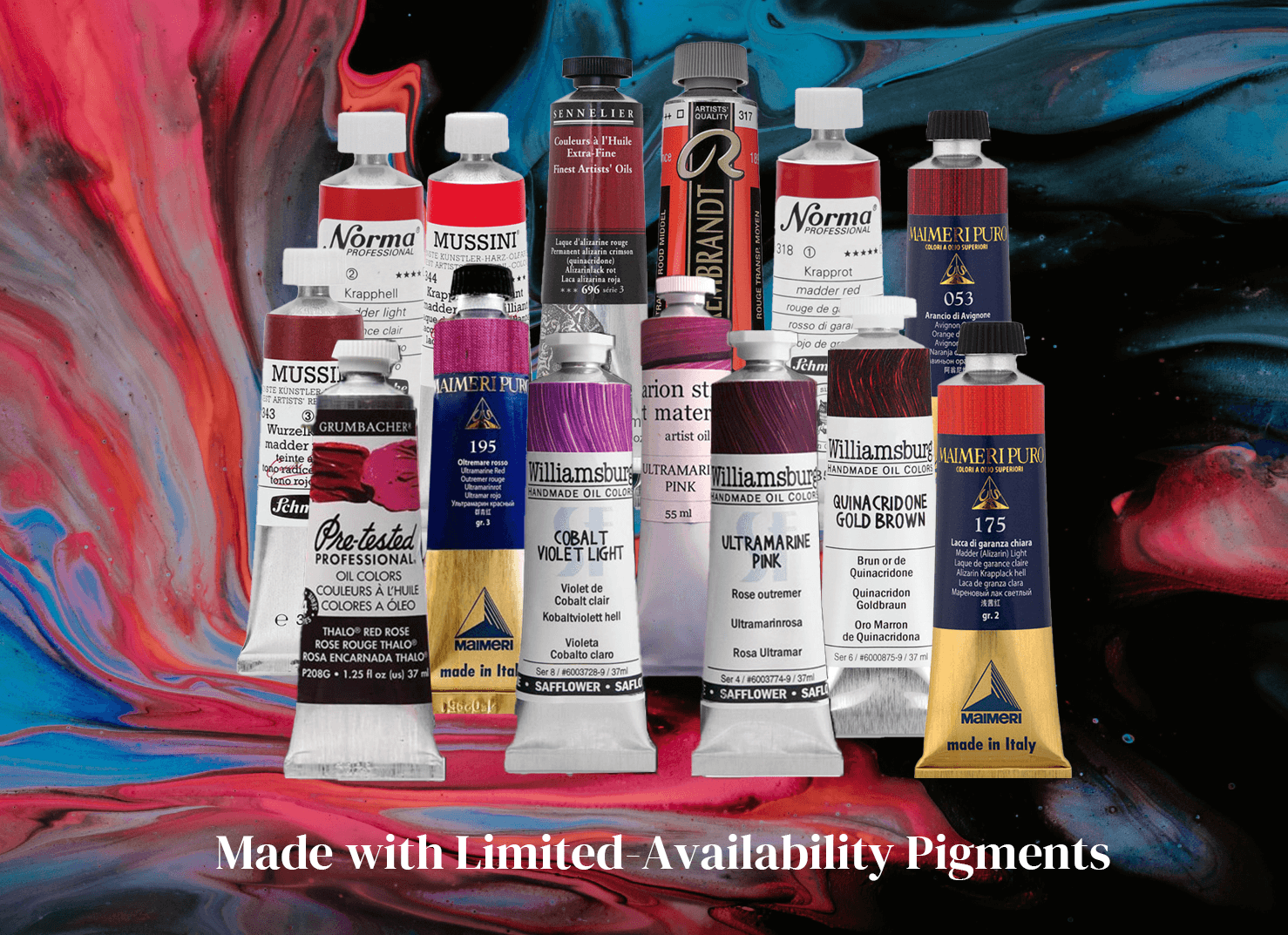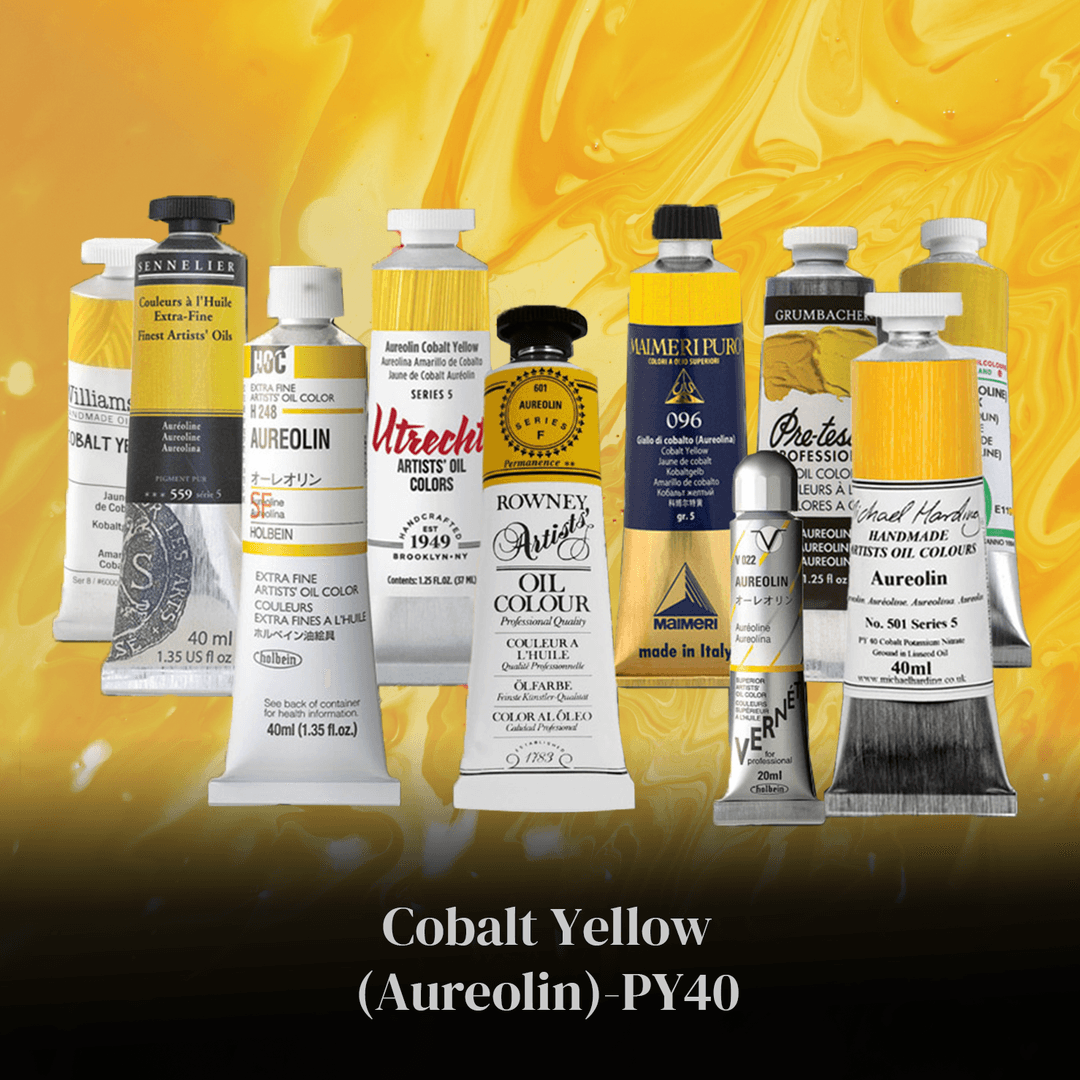Is it true that the quinacridones are gone? Is cobalt yellow still available? And was genuine Alizarin Crimson actually discontinued?
All this and more!

Discontinued Pigments Can Lead to Discontinued Paints: The Recently Lost Pigments and How the Paintlist Can Help
Is it true that the quinacridones are gone? Is cobalt yellow still available? And was genuine Alizarin Crimson actually discontinued?
All this and more!
The Precious Gift of Disappearing Oil Paints
There are a handful of paints (many more than are shown here) that are made with pigments which may not be manufactured anymore.
This article focuses on oil paints, and unfortunately acrylic, watercolor, and other mediums will be affected too.
Ok, so this is by no means a guarantee, but the future is not looking good for certain pigments. This post is based off of Golden's 2023 product discontinuation updates. Update 2024: There are more discontinuations on the horizon including Golden's beloved Earth Tones such as Yellow Ochre and Raw Sienna. See also this video from last year from their Sr. Technical Formulator and Sr. Buyer who works with the pigment supply chain to discuss the challenges in sourcing these pigments.
It is unknown whether other companies will be similarly affected, as each one has its own quantity of pigment in reserves. However it is reasonable to wonder about the availability of certain colors given the relative earthquakes that have been happening in the pigment manufacturing world.
To know for sure whether these colors are going away, one would need to contact the brand and or the manufacturer.

These pigments may be in short supply. Photo credit: background photos by Pawel Czerwinski and JR Corpa, with paint tube photos from Blick.
A mainstay of early 20th century palettes
This one was a shocker! But the good news is it's not quite over yet.
We still can't believe the day has come. This mainstay 20th century favorite appears to be discontinued. However its lightfastness is not good, so, there's that (it's lightfastness III).
Right now most brands still have it, and some may have it for a little white. Williamsburg recently said that they've found another supply and according to their recent updates, they estimate they will have Alizarin Crimson available for another two years.
However other companies have taken note that this pigment may not be available in the future. For example, Gamblin recently announced that they have stopped using PR83 in their 1980 series Alizarin Crimson and will change the formulation to PR177.
For Gamblin's artist/professional series of oils PR83 is not "gone-gone" yet, but Gamblin will no longer be selling cans of this color in oil in their professional Artist Oils line. So if you buy PR83 by the can-ful, at least at the time of this writing, it's still available (you can check their current offerings at Blick here but it looks like it's on the way out. Going forward where they replace PR83 it will be made with a different pigment, Alizarin Permanent, PR177.

So many brands carry/carried genuine Alizarin Crimson. How long they'll carry it depends on how much pigment they have left. Photo credit: background photo from Bangsal Nam, paint tubes via Blick
At the time of this article, these brands still had PR83. If getting genuine PR83 is important, check with the manufacturer to be sure they are still using the genuine version as some have switched over (like Gamblin 1980) to something else.
Tragic Loss of Two Red-Violets
Background photo from Maria Orlova, paint tube photos via Blick
Cobalt Violet Light Of all the discontinuations this one hit hardest. Cobalt Violet Light is perhaps the only relatively lightfast high chroma red violet of its kind. Along with its variant PV14 light, it's a unique single-pigment paint in its color space.
Have you noticed there are not many imitation hues of this incomparable color? The drawbacks are that it is an infamously weak tinter and it does yellow in linseed oil, so the safflower version perhaps a better way to go, but it is not very widely available anymore.
Note: We are not sure if this pigment discontinuation equally affects the PV14 Cobalt Violet Light variety as Williamsburg only uses PV49 as their Cobalt Violet Light pigment. We're really going to miss this one.
Ultramarine Pink This was another staggering loss. We had only recently discovered in the last few years how much we adore this pigment in safflower oil.
There are so few red-violet single pigment colors with good lightfastness. This color makes exceptional blends with greens to neutralize them. If you can still find Williamsburg's version in safflower it's a keeper. At this point we'd be thankful to see the linseed version as the safflower one disappeared abruptly last year. We are going to miss these stunning red-violets.

Cobalt Violet Light (PV49 version) and Ultramarine Pink had good lightfastness in an area of the spectrum where it was hard to find. Photo credit: background photo from Maria Orlova, paint tube photos via Blick
These paints have or contain the specific discontinued PV49 as an ingredient
It's unclear what is happening to other varieties of cobalt violet light. Discover paints named Cobalt Violet Light here.
We're sad to see Ultramarine Pink go. There are several different varieties of Ultramarine Pink, and it may be that not all of them are leaving the scene. Williamsburg's particular variety seemed to be a very special color, and we enjoyed it in mixes with greens.
Not all of these are necessarily discontinued. Williamsburg's particular PV15 pink was lost. Here are some Ultramarine Pinks across brands
A long goodbye
Cobalt Yellow or Aureolin This one is a bit of an enigma with only a lightfastness II, however it's a historical color. Prized by some for glazing and its lower tinting strength, every time the world looses a color it is missed. As of this writing, this color is still available in several brands. Holbein has several varieites, Aureolin in Vernet and Artists' Oil Color, Michael Harding, Utrecht, Maimeri Puro, Old Holland, Blockx, Sennelier, and Grumbacher still seem to be in stock though this is all subject to change. Williamsburg has run out, and we've had trouble finding Blockx Mixed Green, in which PY40 is an ingredient.
Several brands may be able to supply this paint for a long time to come even though the pigment has been discontinued.
Also, check out Golden's lightfastness tests for a few mentions on the lightfastness results of PY40 in combination with various mixing whites.

Aureolin, also known as Cobalt yellow, becoming part of pigment history. Photo credit: background photo from Luis Quintero, paint tubes via Blick
Some brands may be able to stock this for a while. Bear in mind it is only lightfastness II (and maybe lower depending on the mixing white).
We really really hope not.
A question went around on social media about discontinued quinacridones. There are a lot of quinacridones out there and a few are core colors for artists. So the answer to the best of our knowledge is that yes, a few of the specialty quinacridones like PR206 and PR207 are being lost but not the main ones like (not PV19 nor PR122).
Fascinating dark oranges
Quinacridone Burnt Scarlet We are sad to see this pigment go as it's an ASTM 1 with good lightfastness.
This discontinuation affects several oil blends such as Quinacridone Gold Brown by Williamsburg as well as Maimeri Puro's Avignon Orange. We don't know how much pigment Maimeri has left, but Williamsburg has indicated it may have enough to keep this in stock through early 2024.
Williamsburg's color is a fabulous low-lightness high-chroma red brown. Art Spectrum's Quinacridone Maroon may also be affected.

Several quinacridone colors that use PR206. Background Photo by Nathan Duck, Product Photos via Blick
We'll miss these enigmatic dark red-oranges
Several additional blends will be impacted across brands
It's been a long time
Quinacridone Orange We've known that PO48 was a goner for a long time, which is such a shame as it's a terrific color. We love the quinacridones and the way they unfurl their chroma in mixes.
So with PO48 we've just all been hanging on and it's been sort of running on fumes. This discontinuation also affects Quinacridone Gold Brown by Williamsburg. It seems many other companies have already given up the ghost with PO48, with the exception being Daniel Smith. However they are not making traditional oils anymore.
A lovely light red
Quinacridone Red Light We are especially sad to see PR207 leave the scene as it is a beautiful translucent red, a sort of delicate quinacridone red with good lightfastness.
If you love Rembrandt's Transparent Red Medium, Schmincke's Madder Lake Brilliant or Puro's Madder Alizarin light, it might be worth gifitng yourself with an extra. These and a few other blends may become endangered. We are sad to see this one go.

A delicate light red with good lightfastness. Photo credit: background photo by Briana Graham, paint photos via Blick
These are lovely bright reds
Several other blends may see changes
Paint-line specific adjustments
This one just applies to Gamblin. If you love Gamblin's Indanthrone Blue, they just announced that they changed the formulation. So it may already be too late to find old stock if it's even still available. Of course that matters only if the old PB60 in Gamblin's line is a color you particularly love. The new paints will still be PB60, however Gamblin must be using a different pigment supplier. The new one is less of a red-blue and leans a bit more toward middle blue.
They still sell this color, however the hue has changed a bit. These are pictures of the older version.



2020-2023 wrecked havoc on some of the pigments used in artist paint manufacturing. We're still in denial... (sniff, sniff) but with some some of these, their extinction looks like a done deal.
Like we said we still believe in miracles... so, here's hoping these aren't really gone for good. Dear Pigment suppliers, maybe consider making PV49 cobalt violet light and PV15 pink again, ok?
You can use the Paintlist to search by pigment code in order to find which brands may still have paints with these pigments.
Perhaps you’d like to find paints that contain a particular discontinued pigment.
Search the Paint List by the pigment number, such as PR206.
While paints from other brands will differ in many ways (potentially in texture, viscosity, pigment load, additivies, etc.) it may still be helpful if it is a pigment one really enjoys.
A Tip: If the search is taking too long to load, just hit “refresh,” in your browser, or hit Command+R on mac, or Ctrl+F5 on Windows.

A handful of paints that may not be around for very long.
Changes, surprises, and pivots in the painting world
One of the reasons we made the Paintlist was to help track changes in formulations and discontinuations of paints over the years.
As artists we develop methods of working with materials and when formulations change or our favorite paints become discontinued it can be helpful to band together to share how we handle the work arounds.
As always we'll do our best to keep paint pages updated.
We’d love to hear from you:
Has a paint you love been discontinued?
What have you done or what do you plan to do to replace it?
Is there a mix you make that replicates the hue? We’d love to share these insights on the Paint List.
